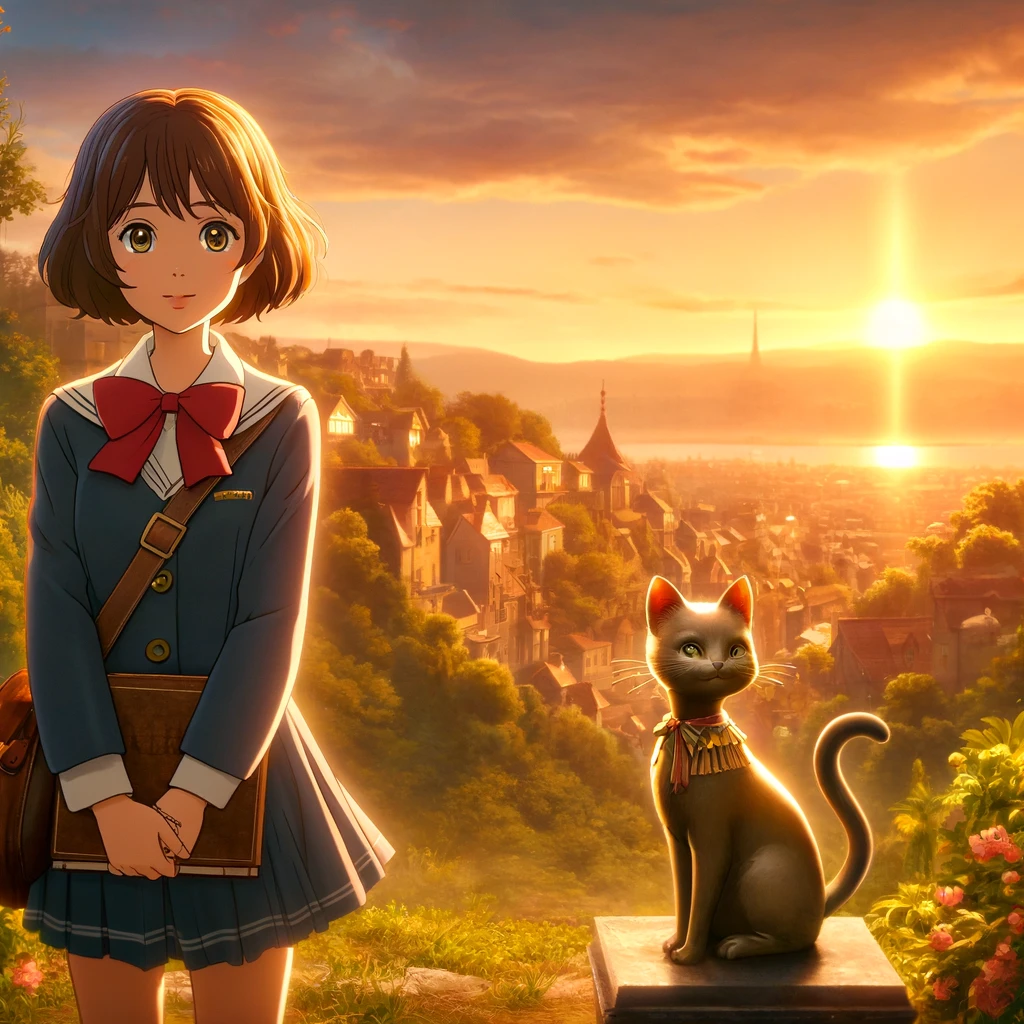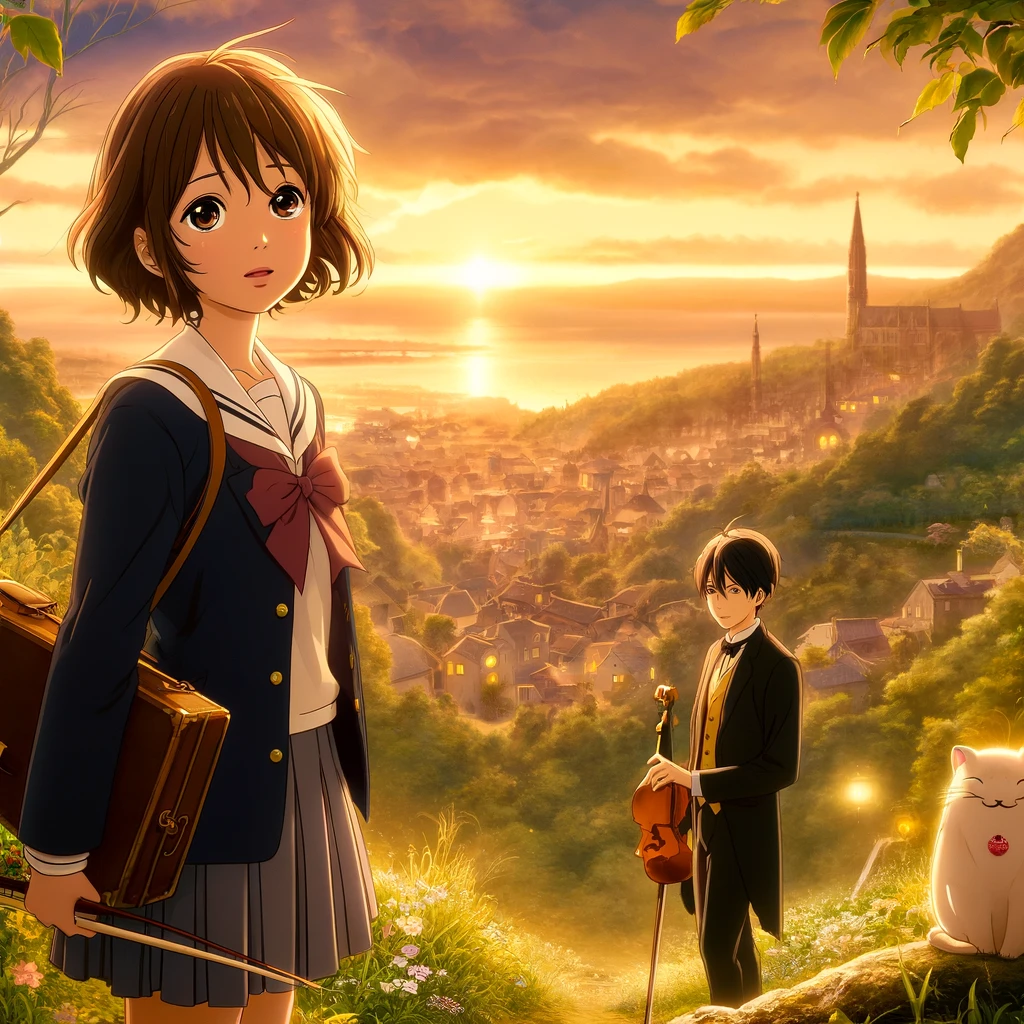
Table of Contents
“Whisper of the Heart,” a 1995 anime film directed by Yoshifumi Kondō and written by Hayao Miyazaki, stands as one of Studio Ghibli’s most poignant and enduring works. Unlike the studio’s more fantastical films, “Whisper of the Heart” is a grounded, slice-of-life story that delves into the themes of self-discovery, the struggles of adolescence, and the pursuit of one’s passions. This review will explore the film’s narrative, characters, themes, and its unique charm that continues to resonate with audiences worldwide.
The Storyline of Whisper of the Heart
At its core, “Whisper of the Heart” is a coming-of-age story centered around Shizuku Tsukishima, a 14-year-old junior high school student living in suburban Tokyo. The film opens with Shizuku discovering that all the books she has borrowed from the library have been previously checked out by someone named Seiji Amasawa. Intrigued by this mysterious book borrower, she sets out to uncover his identity, leading her on a journey that intertwines with her own quest for self-identity and purpose.
Shizuku is an avid reader and a budding writer, often lost in her imaginative world. Her discovery of Seiji’s name acts as a catalyst for her introspection and personal growth. The narrative takes a significant turn when she meets Seiji, who reveals his dream of becoming a master luthier, a maker of stringed instruments. His determination and passion inspire Shizuku to pursue her own dreams of becoming a writer, setting the stage for a beautiful tale of mutual inspiration and young love.
Characters that Breathe Life into Whisper of the Heart
The characters in “Whisper of the Heart” are richly developed, each contributing to the film’s emotional depth and realism. Shizuku Tsukishima, voiced by Yōko Honna, is a relatable protagonist whose journey mirrors the uncertainties and aspirations of adolescence. Her character is defined by curiosity, creativity, and a struggle with self-doubt, making her journey all the more compelling.
Seiji Amasawa, voiced by Issei Takahashi, is Shizuku’s counterpart and love interest. His unwavering dedication to his craft and his willingness to take risks to achieve his dreams serve as a powerful contrast to Shizuku’s initial hesitance. Seiji’s character embodies the themes of perseverance and the pursuit of passion, which are central to the film’s narrative.
Supporting characters such as Shizuku’s parents, her best friend Yuko Harada, and the kindly antique shop owner, Mr. Nishi, enrich the story by providing a broader context to Shizuku’s world. Each character is intricately woven into the narrative, offering guidance, support, and a touch of realism to Shizuku’s journey.
Themes Explored in Whisper of the Heart
“Whisper of the Heart” explores several profound themes that resonate deeply with audiences. One of the most prominent themes is the pursuit of dreams and the challenges that come with it. Both Shizuku and Seiji are at the cusp of adulthood, grappling with the pressure of making significant life choices. The film portrays the courage it takes to follow one’s passion, the fear of failure, and the importance of perseverance.
Another central theme is self-discovery. Shizuku’s journey is not just about finding out who Seiji is, but also about understanding herself. Her decision to write a novel as a way to challenge herself and prove her worth highlights the introspective nature of adolescence. The film beautifully captures the inner turmoil and growth that comes with finding one’s voice and place in the world.
Love and friendship are also delicately portrayed in the film. Shizuku and Seiji’s relationship develops naturally, grounded in mutual respect and admiration. Their bond is a testament to how love can inspire and motivate individuals to become the best versions of themselves. Similarly, Shizuku’s friendships and familial relationships provide a support system that underscores the importance of community and connection.
Visual and Musical Excellence in Whisper of the Heart
Studio Ghibli is renowned for its breathtaking animation, and “Whisper of the Heart” is no exception. The film’s visuals are a feast for the eyes, capturing the beauty of everyday life in Tokyo with meticulous detail. The animation brings to life the bustling cityscape, the serene suburban neighborhoods, and the enchanting antique shop that becomes a significant location in Shizuku’s journey. Each frame is crafted with care, enhancing the film’s emotional impact and immersing the audience in Shizuku’s world.
The film’s musical score, composed by Yuji Nomi, complements the narrative beautifully. The soundtrack features a mix of original compositions and classical pieces, with “Take Me Home, Country Roads” by John Denver serving as a recurring motif. Shizuku’s rendition of this song, with her own translated lyrics, becomes a symbolic expression of her aspirations and journey. The music in “Whisper of the Heart” enhances the storytelling, evoking nostalgia and poignancy.
The Cultural Impact of Whisper of the Heart
Since its release, “Whisper of the Heart” has left an indelible mark on both Japanese and international audiences. Its realistic portrayal of adolescence and the universal themes of dreams, love, and self-discovery have made it a timeless classic. The film’s nuanced storytelling and emotional depth continue to inspire viewers of all ages.
One of the film’s most significant cultural impacts is its influence on how coming-of-age stories are told in animation. “Whisper of the Heart” eschews fantastical elements in favor of a grounded, character-driven narrative, demonstrating that everyday life can be just as magical and compelling as any fantasy. This approach has paved the way for other slice-of-life anime that explore the intricacies of human relationships and personal growth.
The Legacy of Whisper of the Heart
“Whisper of the Heart” remains a beloved gem in Studio Ghibli’s filmography, revered for its heartfelt storytelling and relatable characters. The film’s legacy is evident in its continued popularity and the fondness with which it is remembered by fans. It serves as a testament to the power of animation to convey complex emotions and universal truths.
The film also holds a special place in the history of Studio Ghibli, being the only film directed by Yoshifumi Kondō before his untimely death. Kondō’s direction, combined with Miyazaki’s screenplay, resulted in a work of art that resonates with authenticity and warmth. “Whisper of the Heart” is a reminder of the potential of animation to tell deeply human stories that touch the heart and soul.
Conclusion: Whisper of the Heart as an Enduring Masterpiece
“Whisper of the Heart” is more than just an anime film; it is a heartfelt exploration of the journey to self-discovery and the courage it takes to pursue one’s dreams. Through its relatable characters, beautiful animation, and evocative music, the film captures the essence of adolescence and the universal quest for purpose and identity. It stands as a timeless reminder that the whispers of the heart are worth listening to and that the journey to follow them is a path filled with wonder and growth.
In a world that often demands conformity, “Whisper of the Heart” encourages us to embrace our unique passions and to find our own voice. It is a celebration of youth, creativity, and the enduring power of love and friendship. Whether you are experiencing it for the first time or revisiting it as an old favorite, “Whisper of the Heart” offers a touching and inspiring cinematic experience that leaves a lasting impression on the heart.
